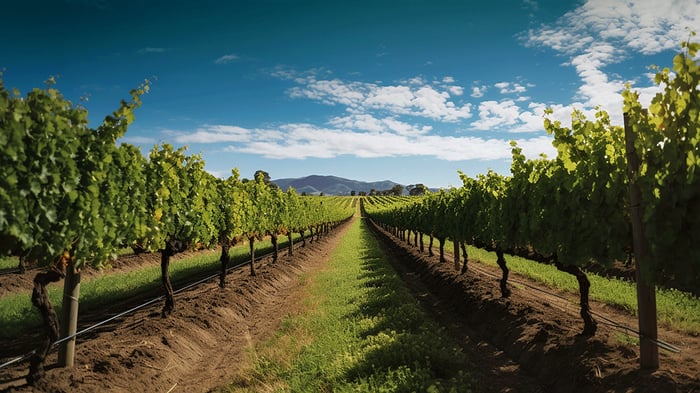You might already be acquainted with the eco-score, a food label inspired by the nutri-score concept, designed to assist consumers in making environmentally conscious choices. In a similar vein, the Wine Sustainability Index gives consumers a tool to understand the environmental impact of the wines they buy. In the context of wine, some labels already exist, but their scope is limited, and they are difficult to understand and compare. A sustainability index like the one we propose is therefore a novel concept. Given the significant environmental impact of the wine industry, with its diverse production methods varying by region and winery, our goal in the realm of the sustainability transition is to comprehensively assess the overall sustainability of the wine industry.
This endeavor brings together three institutions: the Fribourg School of Engineering and Architecture (HEIA-FR), Changins School of Viticulture and Oenology, and EHL Hospitality Business School. During an 18-month research project funded by InnoSuisse, we pooled our different areas of expertise to craft an innovative sustainability index tailored to the wine industry. Now, the question arises: How was this achieved?
The Application of True Cost in the Wine Industry
True Cost, as its name suggests, aims to show the true price of a good (or service), taking into account not only its monetary cost for the entity that produced it, but also all the environmental, social and economic externalities that this good may have entailed throughout its life cycle (i.e., from design through production and distribution to disposal). According to the International Institute for Sustainable Development, “an externality is a positive or negative outcome of a given economic activity that affects a third party that is not directly related to that activity”.
The strengths of this approach lie in the coherent, objective conceptual framework on which it is based. The approach is comprehensive, and all relevant variables are taken into account. In addition, this approach expresses environmental, social, and economic impacts in monetary units, enabling them to be easily compared and aggregated into a global True Cost. These aspects distinguish this approach from existing sustainability indices, which require standardization of the various indicators before they can be aggregated into an index, often with adjustments that can be partially subjective.
In the context of wine, applications of the True Cost approach exist but are scarce. The reason is simple: putting this approach into practice is extremely complex. In particular, precise data for a substantial number of variables must be collected. This can take months of work. This complexity means that the use of the True Cost approach is limited to specific, technical contexts. Moreover, most consumers do not have the knowledge to understand a product's True Cost. This explains why True Cost is typically not communicated to consumers. This obviously greatly reduces the reach of the approach.
The Wine Sustainability Index we propose aims to exploit the strengths of the True Cost approach, while addressing its limitations in a pragmatic way. In concrete terms, the index can be broken down into three levels. The first level is a light version of the model based solely on readily available data; the second level is more detailed and includes variables that require more data collection and analysis efforts; finally, the third level corresponds to the full application of True Cost. All relevant variables are included in this version of the model, they are measured and converted into monetary terms before being aggregated. This requires access to both public and private data. In other words, the index can only be calculated for a wine if its producer provides all the necessary data. Clearly, such an index is not suitable for large-scale implementation, but it does provide the basis for a theoretical ideal towards which we strive. The second level is based on data that already exist and/or can be obtained without major difficulty. This version of the model lends itself well to implementation by retailers (e.g., wine merchants, restaurants), as they have access to that kind of data. Finally, the first level is the one we propose to apply on a large scale. It is based solely on public and easily accessible data. In the context of wine, this is essentially information available on the label. This "level one" version of the model retains all the logic and, in particular, the internal consistency inherent in the True Cost approach.
The only fundamental difference between our model and the True Cost approach is the way in which the result is communicated. In True Cost, the result is an amount expressed in monetary terms. In our application, we propose to convert it into a grade ranging from A to E. This conversion provides greater flexibility to the approach (because one can modulate the thresholds at which the ratings change), and above all it allows the result to be expressed on a scale with which consumers are already familiar. This makes it easier to understand the information content of the index. More generally, the use of such a scale is in line with best practices, as it has been shown that this type of rating/scale has the greatest influence on consumer behavior.
The development of a sustainability index is one of the starting points for transitioning the wine sector towards lower environmental impact.
Sustainability Transition and the Wine Sector
For the wine sector, it is becoming increasingly urgent to address the issue of sustainability in a more comprehensive way. While many studies have focused on the qualities of wine, such as organic and biodynamic production, there is a significant gap in our understanding of how the entire wine industry, from vine to glass, contributes to making the sector more sustainable. This lack of attention is a concern, given the many challenges the wine value chain faces, spanning agriculture, manufacturing, production, and consumption.

One of the key reasons for this urgency is the environmental impact of wine production. From the heavy use of pesticides in vineyards to the carbon footprint of manufacturing, packaging, and transportation, the wine industry has a substantial environmental footprint. To address this, we need to look at the entire value chain and find ways to minimize these impacts. As part of the InnoSuisse mandate, we have carried out an extensive analysis of the existing literature in wine sustainability. Results show that the academic literature has focused particularly on adopting eco-friendly practices in grape growing, improving energy efficiency in production, reducing waste in packaging, and finding ways to reduce emissions in transportation.
Additionally, from an agricultural perspective, the wine sector's reliance on the land is paramount. Sustainable practices not only help the environment but also ensure the long-term health of vineyards. Neglecting this aspect can lead to soil degradation and a decline in the quality of grapes.
From a manufacturing and production perspective, looking at sustainability as a whole can improve efficiency and reduce waste. This means using resources like water and energy more efficiently and finding ways to reduce the environmental impact of production processes.
When it comes to consumption, consumers are increasingly looking for sustainably-produced goods, including wine. Responding to this demand is essential for the wine industry to maintain its market position and reputation.
Lastly, considering the well-being of the communities involved in the wine production process is crucial. Fair labor practices and social responsibility are essential elements of sustainability and have a direct impact on the lives of the men and women working in the wine industry.
Addressing sustainability in the wine sector holistically is essential. It is not just about being eco-friendly; it is about protecting the land, improving efficiency, meeting consumer expectations, and ensuring the well-being of the people involved. This approach is vital for the future of the wine industry, and it is time for all stakeholders to take action to make the wine sector more sustainable.





